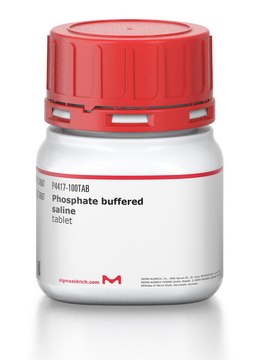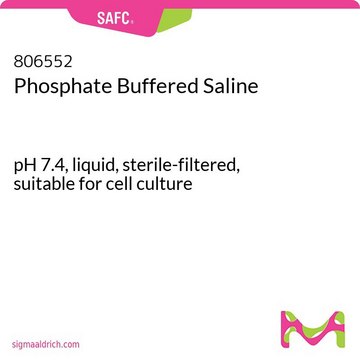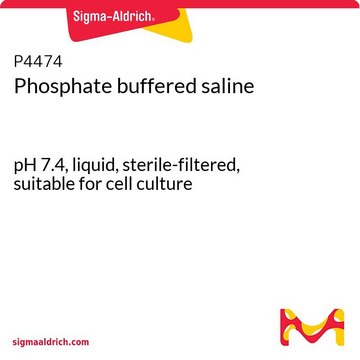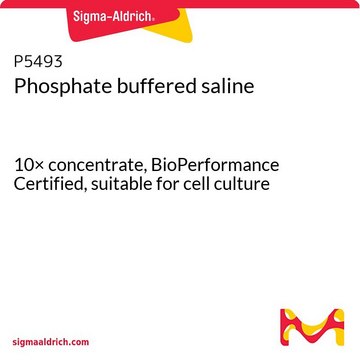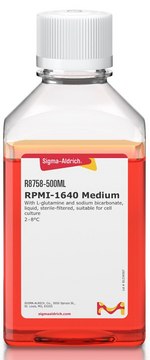D8537
Dulbecco′s Phosphate Buffered Saline
liquid, Modified, without calcium chloride and magnesium chloride, liquid, sterile-filtered, suitable for cell culture
Synonym(s):
DPBS
About This Item
Recommended Products
Product Name
Dulbecco′s Phosphate Buffered Saline, Modified, without calcium chloride and magnesium chloride, liquid, sterile-filtered, suitable for cell culture
Quality Level
sterility
sterile-filtered
form
liquid
technique(s)
cell culture | mammalian: suitable
impurities
endotoxin, tested
components
glucose: no (Dextro)
sodium pyruvate: no
shipped in
ambient
Looking for similar products? Visit Product Comparison Guide
General description
Application
- for the dilution of fresh red blood cells to study the trapping of red blood cell aggregate.
- to wash the wells of a microtiter plate.
- to wash the cells before resuspending them in lysis buffer for DNA isolation.
- as a component of embryo holding medium for vitrification of embryos.
also commonly purchased with this product
Storage Class Code
12 - Non Combustible Liquids
WGK
WGK 1
Flash Point(F)
Not applicable
Flash Point(C)
Not applicable
Choose from one of the most recent versions:
Certificates of Analysis (COA)
Don't see the Right Version?
If you require a particular version, you can look up a specific certificate by the Lot or Batch number.
Already Own This Product?
Find documentation for the products that you have recently purchased in the Document Library.
Which document(s) contains shelf-life or expiration date information for a given product?
If available for a given product, the recommended re-test date or the expiration date can be found on the Certificate of Analysis.
How do I get lot-specific information or a Certificate of Analysis?
The lot specific COA document can be found by entering the lot number above under the "Documents" section.
What is the formulation for Product D8537, Dulbecco's Phosphate?
The formulation for 1 liter is 8 g Sodium Chloride, 0.2 g Potassium Phosphate, monobasic, 1.15 g Sodium Phosphate, dibasic, and 0.2 g Potassium Chloride.
Is Product D8537, Dulbecco's Phosphate, a 1X or 10 X concentration?
This is a 1X concentration. The 10X concentration is listed under product D1408.
What is the pH of a solution of Product D8537, Dulbecco's Phosphate?
The pH will be in the range of 7.1-7.5, according to the specification sheet.
How do I find price and availability?
There are several ways to find pricing and availability for our products. Once you log onto our website, you will find the price and availability displayed on the product detail page. You can contact any of our Customer Sales and Service offices to receive a quote. USA customers: 1-800-325-3010 or view local office numbers.
What is the Department of Transportation shipping information for this product?
Transportation information can be found in Section 14 of the product's (M)SDS.To access the shipping information for this material, use the link on the product detail page for the product.
What is a Salt Toxicity Test?
The Cell Culture assay is called a Salt Toxicity Test (previously called Cell Culture Salt Testing). A more complete description is below:Cells are harvested and counted. They are resuspended in DPBS and incubated at 37°C, 5% CO2 for 1 hour. The cells are counted and %viability determined. The cells are then cultured for an additional 7 hours (total of 8 hours). The cells are counted again and the % viability determined. The viability at 1 hr has to be >95% of the original viability. The viability at 8 hrs must be >75% of the original viability.
My question is not addressed here, how can I contact Technical Service for assistance?
Ask a Scientist here.
Protocols
Cell culture protocol for passaging and splitting adherent cell lines using trypsin EDTA. Free ECACC handbook download.
Cell culture protocol for high cell viability freezing using cryopreservation reagents like DMSO. Free handbook download.
Technical information for working with rat skeletal muscle cells including thawing, subculturing and cryopreservation
Osteogenesis, adipogenesis and chondrogenesis differentiation protocols and media for human mesenchymal stem cell culture. Explore over 350 PromoCell products on our company website.
Related Content
Discover our primary human intrahepatic biliary epithelial cells, also known as cholangiocytes. Explore our plating and maintenance media formulations and protocol for culture.
Learn how to use our cell culture tested, ready-to-use MilliShot™ single dose antibiotic solutions, conveniently packaged in one-time use vials.
Our team of scientists has experience in all areas of research including Life Science, Material Science, Chemical Synthesis, Chromatography, Analytical and many others.
Contact Technical Service